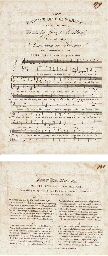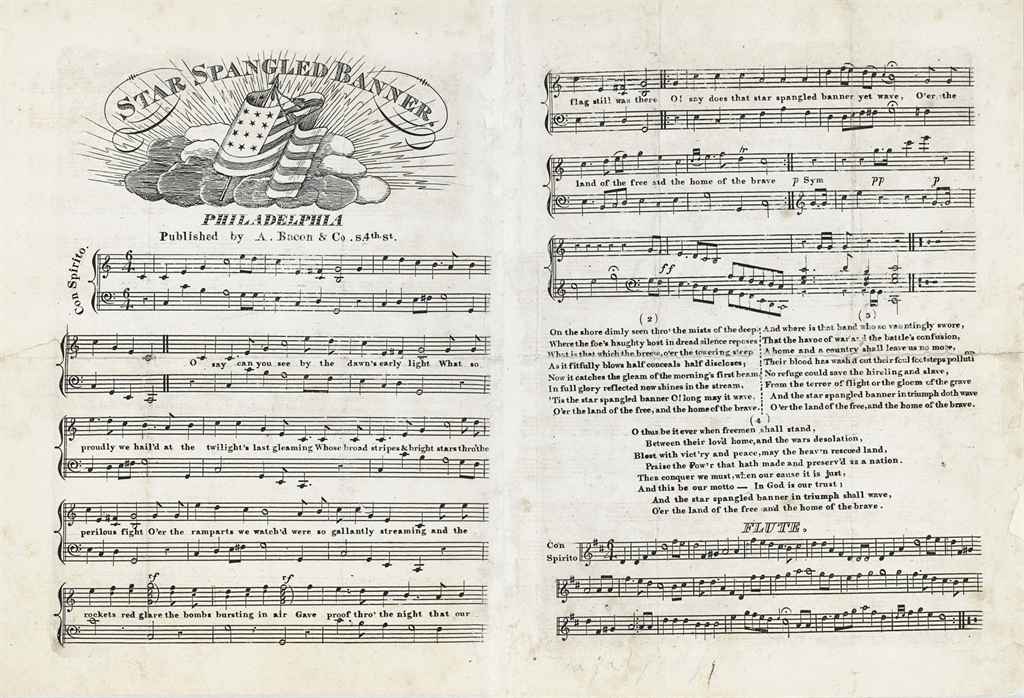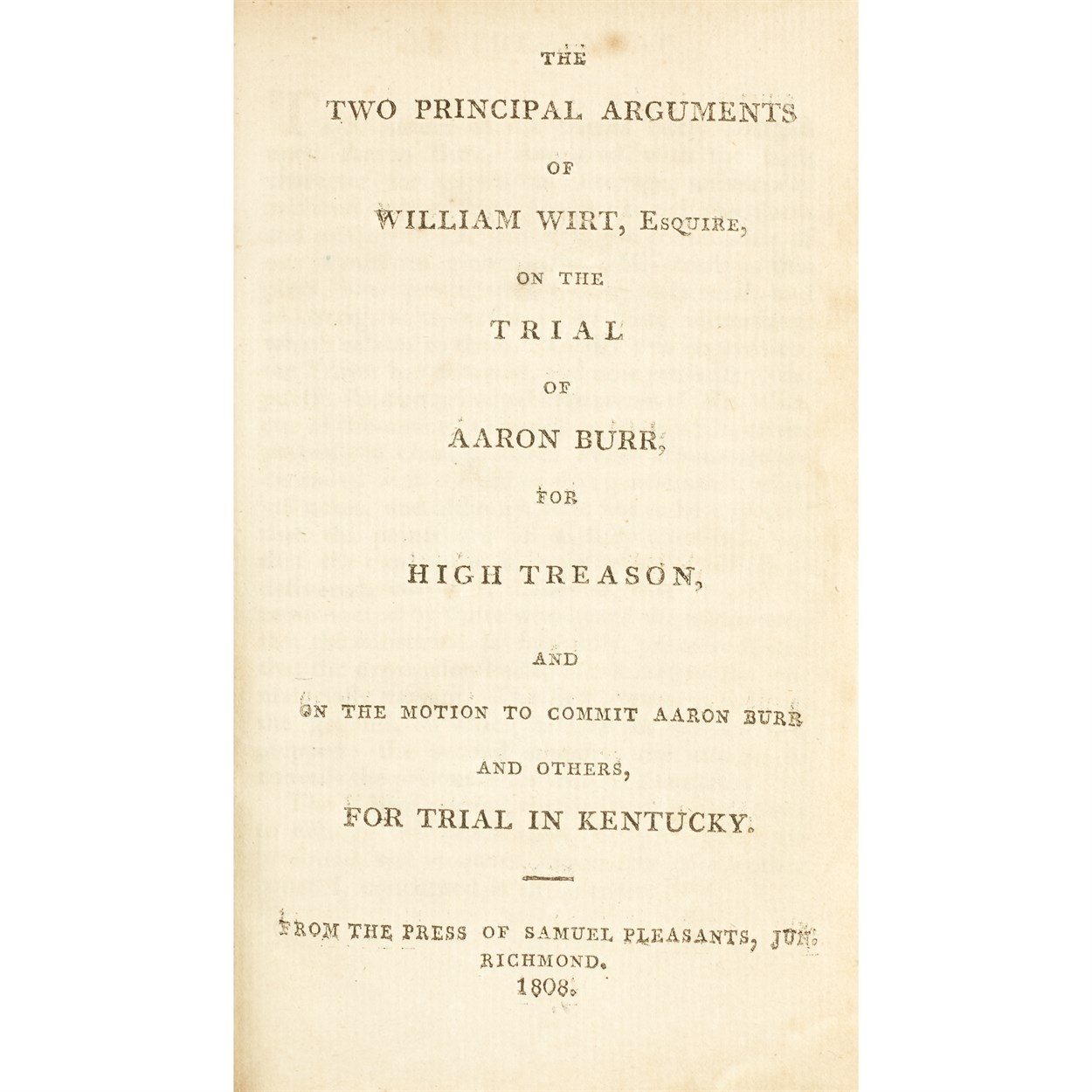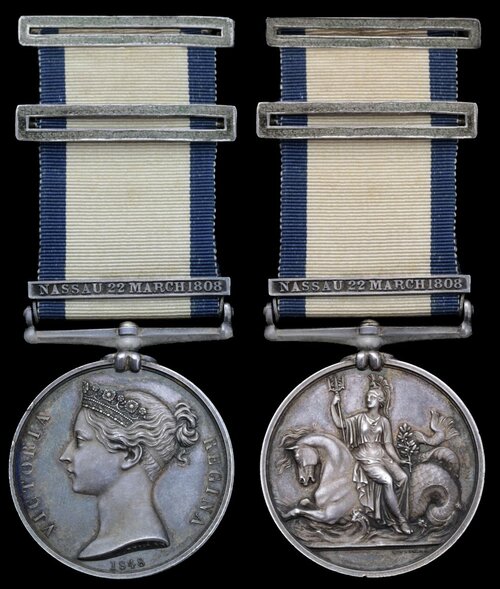KEY, Francis Scott (1780-1843), Poet ]. The Star Spangled Banner. A Pariotic [sic] Song . Baltimore, Printed and Sold at Carr's Music Store, 36 Baltimore Street, n.d. [September-November 1814]. Bound ca. 1820 in an album belonging to Mary Barnitz of York, Pa. (1793-1886) or to her father George (1770-1844), containing 49 pieces of popular sheet music of the era. (List available on request.)
KEY, Francis Scott (1780-1843), Poet ]. The Star Spangled Banner. A Pariotic [sic] Song . Baltimore, Printed and Sold at Carr's Music Store, 36 Baltimore Street, n.d. [September-November 1814]. Bound ca. 1820 in an album belonging to Mary Barnitz of York, Pa. (1793-1886) or to her father George (1770-1844), containing 49 pieces of popular sheet music of the era. (List available on request.) 2 pages, 4to, 338 x 245 mm. (13. x 9. 1/2 in.), printed from two engraved plates on pages 2 and 3 of a bifolium. (Neatly removed from the album, small stain to upper margin, light foxing, neat mends to lower left-hand corner of first sheet.) "AND THE STAR-SPANGLED BANNER IN TRIUMPH SHALL WAVE O'ER THE LAND OF THE FREE, AND THE HOME OF THE BRAVE..." FIRST EDITION OF THE LYRICS AND MUSIC OF "THE STAR-SPANGLED BANNER," THE STIRRING NATIONAL ANTHEM THE ONLY COPY IN PRIVATE HANDS: ONE OF ELEVEN KNOWN COPIES Francis Scott Key's famous patriotic verses were inspired by a shipboard vigil on the night of September 13-14, 1814, when a British naval flotilla bombarded Fort McHenry for hours, prefatory to a planned full-scale assault. Key, a young lawyer, and a colleague had gone on board a British ship under a flag of truce to secure the release of an American physician, Dr. William Beanes, held as a prisoner. To ensure that no military information on the impending attack could be passed to the American defenders, Key too was detained. He spent the night on the deck of the flag-of-truce sloop, which gave him a sweeping view of the dramatic scene. He watched anxiously as British naval cannon-fire and incendiary bombs and rockets rained onto the American fort. During the shelling, the very large stars and stripes flag flying from the fort's ramparts was clearly visible, giving heartening evidence that the fort's defenses had weathered the storm of shot and shell. But when the bombardment unexpectedly ceased, the American flag was obscured. Key was heart-sick. Had the fort been forced to surrender? But at dawn, when the smoke of the shelling lifted, the flag was again visible. Key's patriotic emotions were powerfully stirred by the welcome sight. His first draft of the anthem was written on shipboard, on the back of a letter, then a final version, containing four 8-line stanzas, was completed in the next few days upon Key's return to Baltimore. His rousing song perfectly mirrored Americans' heightened patriotic fervor in the wake of the destruction of Washington and the bombardment of Fort McHenry. Broadside and newspaper printings under the title "The Defence of Fort McHenry," swiftly circulated. The verses' runaway popularity was given strong impetus when Key's lyrics were set to the tune of a well-known drinking tune "The Anacreontic Song," attributed to the English composer, John Stafford Smith (1740-1846). (On Smith's music see Richard S. Hill "The Melody of the Star-Spangled Banner," in Essays Honoring Lawrence C. Wroth , Portland, 1915.) Capitalizing on the great popularity for the song, the enterprising Baltimore music publisher Thomas Carr (1780-1849) quickly engraved and printed words and music together. Signs are that it was a rushed job: the name of the poet, Francis Scott Key, was omitted, and the heading proclaimed the song to be "A Pariotic Song." The sheet-music edition of the song was available for purchase at Carr's shop before 18 November. In an amended issue from the same plates, Carr corrected the misspelling: parts of the copperplate were rubbed out and re-engraved to read "A Celebrated Patriotic Song." No doubt the sheet-music--despite its spelling errors--enjoyed a brisk sale at the time and for years afterwards. Today, though, only 11 copies of the first edition are recorded; all but the present, newly discovered copy are in public institutions. This constitutes THE LAST COPY IN PRIVATE HANDS. CENSUS OF COPIES OF THE STAR-SPANGLED BANNER 1. Library of Congress 2. Indiana University, Lilly Library 3. Maryland Historica
KEY, Francis Scott (1780-1843), Poet ]. The Star Spangled Banner. A Pariotic [sic] Song . Baltimore, Printed and Sold at Carr's Music Store, 36 Baltimore Street, n.d. [September-November 1814]. Bound ca. 1820 in an album belonging to Mary Barnitz of York, Pa. (1793-1886) or to her father George (1770-1844), containing 49 pieces of popular sheet music of the era. (List available on request.)
KEY, Francis Scott (1780-1843), Poet ]. The Star Spangled Banner. A Pariotic [sic] Song . Baltimore, Printed and Sold at Carr's Music Store, 36 Baltimore Street, n.d. [September-November 1814]. Bound ca. 1820 in an album belonging to Mary Barnitz of York, Pa. (1793-1886) or to her father George (1770-1844), containing 49 pieces of popular sheet music of the era. (List available on request.) 2 pages, 4to, 338 x 245 mm. (13. x 9. 1/2 in.), printed from two engraved plates on pages 2 and 3 of a bifolium. (Neatly removed from the album, small stain to upper margin, light foxing, neat mends to lower left-hand corner of first sheet.) "AND THE STAR-SPANGLED BANNER IN TRIUMPH SHALL WAVE O'ER THE LAND OF THE FREE, AND THE HOME OF THE BRAVE..." FIRST EDITION OF THE LYRICS AND MUSIC OF "THE STAR-SPANGLED BANNER," THE STIRRING NATIONAL ANTHEM THE ONLY COPY IN PRIVATE HANDS: ONE OF ELEVEN KNOWN COPIES Francis Scott Key's famous patriotic verses were inspired by a shipboard vigil on the night of September 13-14, 1814, when a British naval flotilla bombarded Fort McHenry for hours, prefatory to a planned full-scale assault. Key, a young lawyer, and a colleague had gone on board a British ship under a flag of truce to secure the release of an American physician, Dr. William Beanes, held as a prisoner. To ensure that no military information on the impending attack could be passed to the American defenders, Key too was detained. He spent the night on the deck of the flag-of-truce sloop, which gave him a sweeping view of the dramatic scene. He watched anxiously as British naval cannon-fire and incendiary bombs and rockets rained onto the American fort. During the shelling, the very large stars and stripes flag flying from the fort's ramparts was clearly visible, giving heartening evidence that the fort's defenses had weathered the storm of shot and shell. But when the bombardment unexpectedly ceased, the American flag was obscured. Key was heart-sick. Had the fort been forced to surrender? But at dawn, when the smoke of the shelling lifted, the flag was again visible. Key's patriotic emotions were powerfully stirred by the welcome sight. His first draft of the anthem was written on shipboard, on the back of a letter, then a final version, containing four 8-line stanzas, was completed in the next few days upon Key's return to Baltimore. His rousing song perfectly mirrored Americans' heightened patriotic fervor in the wake of the destruction of Washington and the bombardment of Fort McHenry. Broadside and newspaper printings under the title "The Defence of Fort McHenry," swiftly circulated. The verses' runaway popularity was given strong impetus when Key's lyrics were set to the tune of a well-known drinking tune "The Anacreontic Song," attributed to the English composer, John Stafford Smith (1740-1846). (On Smith's music see Richard S. Hill "The Melody of the Star-Spangled Banner," in Essays Honoring Lawrence C. Wroth , Portland, 1915.) Capitalizing on the great popularity for the song, the enterprising Baltimore music publisher Thomas Carr (1780-1849) quickly engraved and printed words and music together. Signs are that it was a rushed job: the name of the poet, Francis Scott Key, was omitted, and the heading proclaimed the song to be "A Pariotic Song." The sheet-music edition of the song was available for purchase at Carr's shop before 18 November. In an amended issue from the same plates, Carr corrected the misspelling: parts of the copperplate were rubbed out and re-engraved to read "A Celebrated Patriotic Song." No doubt the sheet-music--despite its spelling errors--enjoyed a brisk sale at the time and for years afterwards. Today, though, only 11 copies of the first edition are recorded; all but the present, newly discovered copy are in public institutions. This constitutes THE LAST COPY IN PRIVATE HANDS. CENSUS OF COPIES OF THE STAR-SPANGLED BANNER 1. Library of Congress 2. Indiana University, Lilly Library 3. Maryland Historica










Try LotSearch and its premium features for 7 days - without any costs!
Be notified automatically about new items in upcoming auctions.
Create an alert